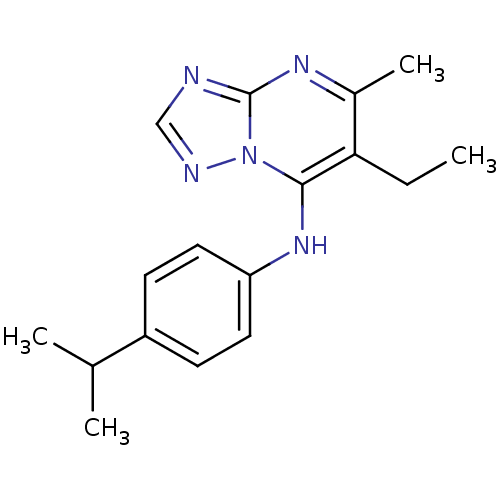null
SMILES CCc1c(C)nc2ncnn2c1Nc1ccc(cc1)C(C)C
InChI Key InChIKey=HSKDDEMAAZUZGH-UHFFFAOYSA-N
Activity Spreadsheet -- Enzyme Inhibition Constant Data from BindingDB
 Found 3 hits for monomerid = 50345437
Found 3 hits for monomerid = 50345437
TargetDihydroorotate dehydrogenase (quinone), mitochondrial(Plasmodium falciparum (isolate 3D7))
BOARD OF REGENTS, THE UNIVERSITY OF TEXAS SYSTEM; MMV MEDICINES FOR MALARIA VENTURE; UNIVERSITY OF WASHINGTON
US Patent
BOARD OF REGENTS, THE UNIVERSITY OF TEXAS SYSTEM; MMV MEDICINES FOR MALARIA VENTURE; UNIVERSITY OF WASHINGTON
US Patent
Affinity DataIC50: 1.66E+3nMpH: 8.0Assay Description:For studying inhibition of Plasmodium or human DHODH enzyme, two assays that are in routine use are described, for example, in Baldwin, et al. (2002)...More data for this Ligand-Target Pair
TargetDihydroorotate dehydrogenase (quinone), mitochondrial(Homo sapiens (Human))
University of Washington
Curated by ChEMBL
University of Washington
Curated by ChEMBL
Affinity DataIC50: 1.00E+5nMAssay Description:Inhibition of His6-tagged recombinant human dihydroorotate dehydrogenase expressed in Escherichia coli using L-dihydroorotate as substrate after 10 t...More data for this Ligand-Target Pair
TargetDihydroorotate dehydrogenase (quinone), mitochondrial(Plasmodium falciparum)
University of Washington
Curated by ChEMBL
University of Washington
Curated by ChEMBL
Affinity DataIC50: 1.70E+3nMAssay Description:Inhibition of His6-tagged recombinant Plasmodium falciparum dihydroorotate dehydrogenase expressed in Escherichia coli using L-dihydroorotate as subs...More data for this Ligand-Target Pair
